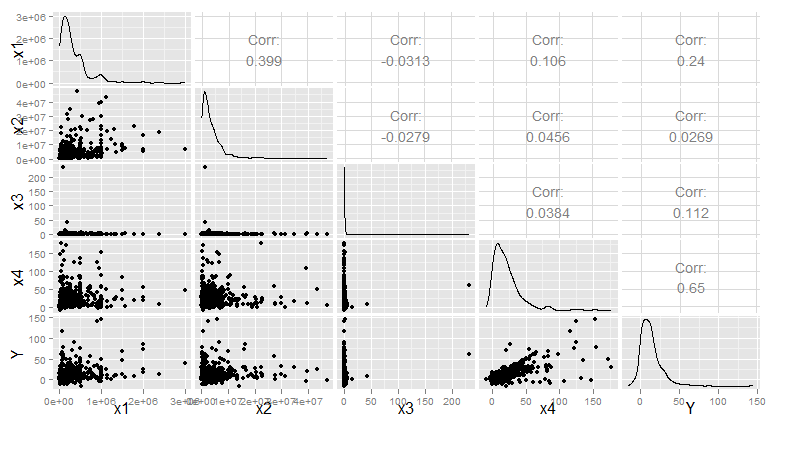I am testing to see if there is a relationship between my dependent variable Y and any of 4 explanitory variables x1, x2, x3 or x4
First I started by doing simple linear regression and got these results:
fit<-lm( Y ~ x1 , data=data)
summary(fit) # R square .05
fit<-lm( Y ~ x2, data=data)
summary(fit) # R square -.001
fit<-lm( Y ~ x3 , data=data)
summary(fit) # R square .01
fit<-lm( Y ~ x4, data=data)
summary(fit) ###### R square .42
fit<-lm( Y ~ x1+ x2+ x3 + x4, data=data)
summary(fit) ####### R square .46
So looking at those results I don't see much. There is an R squared of .42 and .46 when I am regress x4 but it is only .42. I am thinking that there is not relationship here. Am I correct?
I looked into scaling because X1 and X2 are larger in scale but the regression results and R squared values did not change here are the min/max for X1, X2, X3, X4:
summary(as.numeric(data$x1) )
summary(as.numeric(data$x2) )
summary(as.numeric(data$x3) )
summary(as.numeric(data$x4) )
> summary(as.numeric(data$x1) )
Min. 1st Qu. Median Mean 3rd Qu. Max.
2500 100000 209200 333100 500000 3000000
> summary(as.numeric(data$x2) )
Min. 1st Qu. Median Mean 3rd Qu. Max.
57440 1146000 2603000 4395000 5142000 47050000
> summary(as.numeric(data$x3) )
Min. 1st Qu. Median Mean 3rd Qu. Max.
0.01667 0.33330 0.51670 1.52400 1.50000 232.50000
> summary(as.numeric(data$x4) )
Min. 1st Qu. Median Mean 3rd Qu. Max.
-9.187 6.814 16.700 22.920 29.590 177.300
I also looked at the residuals of the fit<-lm( Y ~ x1+ x2+ x3 + x4, data=data) regression to see if the residuals were normal and there are not. I used a qqnorm plot, jarque bera and shapiro wilk:
r<-resid(fit)
plot(r)
qqnorm(r) # residual does not look normal there are huge diviations in the tails
qqline(r)
jarque.bera.test(r) #pvalue < .05 so residual is not normal
shapiro.test(r) #pvalue <.05 so residual is not normal
Since the residuals are not normal I am concluding that fit<-lm( Y ~ x1+ x2+ x3 + x4, data=data) is not a good model. Is that correct?
here is a plot of the data

here is plot(fit)

I am new to multivariable regression and was wondering if you could advise me what if anything I could/should do next to determine is there is a relationship. Are there other strategies I should look at to see if there is a relationship.
Thank you for your time. Here are the actual regression results:
> fit<-lm( Y ~ x1 , data=data)
> summary(fit)
Call:
lm(formula = Y ~ x1, data = data)
Residuals:
Min 1Q Median 3Q Max
-32.080 -9.428 -3.143 4.303 123.535
Coefficients:
Estimate Std. Error t value Pr(>|t|)
(Intercept) 1.007e+01 9.560e-01 10.532 < 2e-16 ***
x1 1.144e-05 1.965e-06 5.821 9.93e-09 ***
---
Signif. codes: 0 ‘***’ 0.001 ‘**’ 0.01 ‘*’ 0.05 ‘.’ 0.1 ‘ ’ 1
Residual standard error: 16.4 on 552 degrees of freedom
Multiple R-squared: 0.05783, Adjusted R-squared: 0.05613
F-statistic: 33.88 on 1 and 552 DF, p-value: 9.926e-09
> fit<-lm( Y ~ x2, data=data)
> summary(fit)
Call:
lm(formula = Y ~ x2, data = data)
Residuals:
Min 1Q Median 3Q Max
-30.630 -10.064 -3.525 4.662 131.045
Coefficients:
Estimate Std. Error t value Pr(>|t|)
(Intercept) 1.354e+01 8.921e-01 15.181 <2e-16 ***
x2 7.634e-08 1.206e-07 0.633 0.527
---
Signif. codes: 0 ‘***’ 0.001 ‘**’ 0.01 ‘*’ 0.05 ‘.’ 0.1 ‘ ’ 1
Residual standard error: 16.89 on 552 degrees of freedom
Multiple R-squared: 0.000725, Adjusted R-squared: -0.001085
F-statistic: 0.4005 on 1 and 552 DF, p-value: 0.5271
> fit<-lm( Y ~ x3 , data=data)
> summary(fit)
Call:
lm(formula = Y ~ x3, data = data)
Residuals:
Min 1Q Median 3Q Max
-29.660 -10.207 -3.195 4.666 130.886
Coefficients:
Estimate Std. Error t value Pr(>|t|)
(Intercept) 13.59186 0.72132 18.843 < 2e-16 ***
x3 0.18843 0.07093 2.657 0.00812 **
---
Signif. codes: 0 ‘***’ 0.001 ‘**’ 0.01 ‘*’ 0.05 ‘.’ 0.1 ‘ ’ 1
Residual standard error: 16.79 on 552 degrees of freedom
Multiple R-squared: 0.01262, Adjusted R-squared: 0.01084
F-statistic: 7.058 on 1 and 552 DF, p-value: 0.008122
> fit<-lm( Y ~ x4, data=data)
> summary(fit)
Call:
lm(formula = Y ~ x4, data = data)
Residuals:
Min 1Q Median 3Q Max
-69.302 -4.355 -0.970 4.667 81.136
Coefficients:
Estimate Std. Error t value Pr(>|t|)
(Intercept) 3.94034 0.73664 5.349 1.3e-07 ***
x4 0.43353 0.02159 20.081 < 2e-16 ***
---
Signif. codes: 0 ‘***’ 0.001 ‘**’ 0.01 ‘*’ 0.05 ‘.’ 0.1 ‘ ’ 1
Residual standard error: 12.84 on 552 degrees of freedom
Multiple R-squared: 0.4221, Adjusted R-squared: 0.4211
F-statistic: 403.2 on 1 and 552 DF, p-value: < 2.2e-16
> fit<-lm( Y ~ x1+ x2+ x3 + x4, data=data)
> summary(fit)
Call:
lm(formula = Y ~ x1 + x2 + x3 + x4, data = data)
Residuals:
Min 1Q Median 3Q Max
-63.697 -4.918 -0.487 4.119 76.460
Coefficients:
Estimate Std. Error t value Pr(>|t|)
(Intercept) 1.744e+00 8.672e-01 2.012 0.04476 *
x1 9.994e-06 1.625e-06 6.150 1.49e-09 ***
x2 -2.351e-07 9.639e-08 -2.439 0.01505 *
x3 1.552e-01 5.236e-02 2.964 0.00317 **
x4 4.189e-01 2.094e-02 20.007 < 2e-16 ***
---
Signif. codes: 0 ‘***’ 0.001 ‘**’ 0.01 ‘*’ 0.05 ‘.’ 0.1 ‘ ’ 1
Residual standard error: 12.37 on 549 degrees of freedom
Multiple R-squared: 0.4665, Adjusted R-squared: 0.4627
F-statistic: 120 on 4 and 549 DF, p-value: < 2.2e-16
